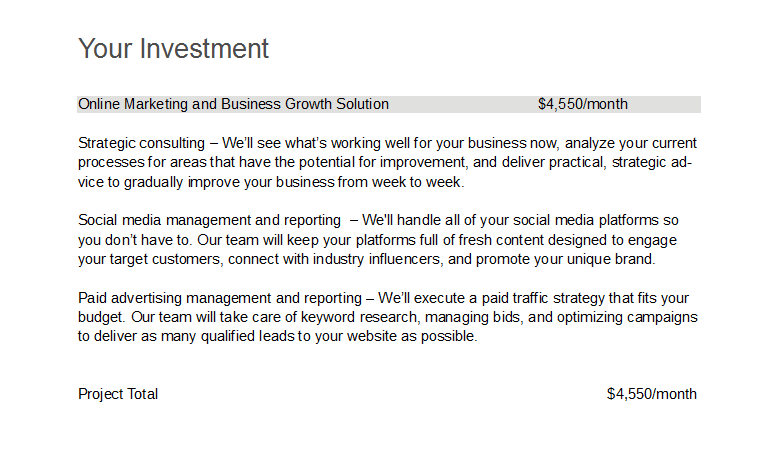
When you have bills that show up on a regular basis but work that only brings in money when it’s available (and after you’ve put in the time), things can get stressful in a hurry.
This isn’t just a problem for new freelancers either. The “feast or famine” problem can affect seasoned pros too.
The key to handling this problem is to often look beyond traditional freelancing and diversify into different types of agreements – especially reoccurring income sources like products or retainer agreements.
Solid retainer agreements with your best clients allow you to plan your work well in advance. They also even out those stressful income fluctuations and enable you to take on other clients on your terms.
Retainers can give you the financial freedom and stability you’ve been dreaming about… if you’re careful when setting them up.
Just like traditional contracts may go away from a deadbeat client refusing to pay, a poorly-planned retainer agreement puts you in a position to be taken advantage of.
The goal: make yourself available to a client in exchange for a predictable income, adding stability for both parties involved
Interested? Want to find out how to pitch a retainer contract to clients and make them work for you?
If you’re looking for a steadier stream of income or for a way to supplement your traditional hourly work, listen up and take notes!
Image credit: FirmBee
What Work Should You Offer?
One of the first steps to making a retainer work for you is to decide what sort of services you can realistically offer. You’ll find that some of your typical work probably won’t be the best fit for a retainer agreement.
For a marketer, a marketing agreement might include a retainer option, “Deliver one article a week and two guest posts per month.”
But what about for someone who develops websites or handles maintenance? Left ambiguous, a retainer arrangement can lead to way too many calls, emails, and requests. All the little details eat up too much time to make it worthwhile.
This article will help you pinpoint which of your services would be the best fits for retainer gigs.
Services That Work Well for Retainer Agreements
- Handling routine (i.e., not out of the ordinary) maintenance work that may not get done without you
- Being on call for emergency issues (clearly define what constitutes an “emergency”)
- Offering extremely fast turnaround for routine tasks
- Consulting on strategy or planning for the company
- Handling reoccurring work (like a set number of articles per week, as mentioned above)
- Ongoing reporting and/or monitoring
One must-do is to outline specifically: 1) what work you’ll be doing, and 2) how much time you can commit to the arrangement.
Tracking Your Time
Being at someone’s beck-and-call can get out of hand when they start paying you every month. They might start demanding too many hours. Prevent this by having an agreement that specifies X hours, and if they want X+Y, they’ll have to pay extra.
Don’t know how much time you’re dedicating to each client? Our integration with time-tracking software Harvest makes it simple to find out!
You’ll also want to keep tabs on the agreement as time goes on. One of the best ways to make sure your retainer is working out for you (and your client) is to track your time closely. Is your rate per hour higher, the same, or less than before?
Once the ink hits the paper, use tools like Harvest or Toggl to monitor hours spent working on a retainer contract vs. your monthly retainer fee (time-tracking 101, you’re likely already doing this). You can find even more productivity and time-tracking tools on our massive list of freelance resources.
The objective?
Know how much you’re really earning per hour. If you discover you aren’t working close to your target rate, you can make a move to renegotiate the terms or price, or you can cancel the contract and move on.
Image credit: websubs
Pitching the Idea to Clients
We all know that a perfect proposal appeals to a client’s needs, so you can be sure that it takes a bit of positioning to successfully pitch the idea of a retainer agreement to clients.
Here’s a screenshot from our free marketing retainer proposal template to give you an idea of what it might look like:
And here’s another retainer proposal from our web design template (also free):
First things first. The reason that you’re interested in a retainer agreement is that, at some point in building your business, you found that you were doing more and more work for a smaller segment of important clients.
These are the clients you need to target for retainer agreements.
Why?
Since these clients have slowly been “funneled” by your premium rates, it’s clear that you kept them around for a reason: they pay well and on time.
Because you won’t have to worry about marketing yourself so much when you have a few solid retainer contracts, it makes sense to take relationships with these top-tier clients beyond an hourly basis.
Your best clients can afford it. And you get an opportunity to spend less time on promotion – and more time on getting paid.
It’s 80/20 rule that plays out in many a freelancing career. We soon realize that only 20 percent of our clients are producing the lion’s share of our income.
To sweeten the deal, these super clients are usually the most willing to commit to retainers since your expenses aren’t as big of a dent in their budget as a smaller client.
In short, these are the people you dream of finding when you’re just starting out and searching far and wide for those very first clients.
Here are a few ways you make it a “no-brainer” for these winning clients to see the value in a retainer contract with you:
Remind Them of Your Dependability
If you’ve been over-delivering on your contract work, the thought of hiring you on retainer has probably already been discussed, or at least mentioned.
It’s no surprise then that the best thing to remind your clients of is how much value you’ve delivered on such a consistent basis.
Make it obvious that you’re serious about transforming this relationship into something more consistent, and put your track record front and center to let it speak for itself.
Be like Han Solo: calm, collected, and confident in your ability to create value.
Do The Math for Them
If a client just closed two $2,500 contracts with you over the span of 2 months, a $4k+ monthly retainer sounds like a deal if they plan on having more projects in the future.
You get to stop chasing clients and work with the best, and they get to save money and have you available for regular work. They get to save the time they would have spent trolling freelance brokering websites looking for help from someone else.
Offer Different Levels of Commitments
Sure, a 3-month retainer may sound great to you (especially if it’s with an ideal client), but many people are scared of commitments.
Instead, you could offer a monthly retainer that requires a notice to cancel and an extended retainer contract for those clients who are ready to invest in your time.
Just like how you position your prices for your “regular” freelance work, remember that retainers don’t have to be sold as a single package.
Assemble Benchmark Reports
If your work directly contributes to closely-monitored metrics (a better customer experience, more conversions, or more leads/traffic if you’re a content creator), offer to assemble quick reports on how your work has improved their business.
This is especially useful if you’re looking to land a long-term agreement (six months or more), as it will put many business owners at ease to see that you’re taking an active interest in delivering measurable results.
Give Both of You an Easy Way Out
As counterproductive as this might seem, trust me, you’ll want to include an easy way to end this relationship.
The thing is, great clients rarely go sour unless there is a change in management, and you can almost always tell if a contract isn’t going to work out shortly after it’s been signed.
For these “barnacle” clients, you’ll want a way to easily escape that’s written into the contract. For top-tier clients, this serves as more or less a guarantee, and since they are the least likely to use it, it really is a win-win for both of you.
Image credit: Robert_C
The Finishing Touches
If you’re ready to start making moves on getting clients on retainer, let me offer one final word of warning: you must get certain things down in writing or you’ll end up in trouble.
It’s not rocket science either, just a few basic, iron-clad parameters that will keep you safe from rotten clients. Any upstanding client will understand the need for it and won’t offer you resistance.
Make sure all the following details make it into your retainer contract:
- The amount you’re to receive each month
- The date you’re to be paid by
- Any invoicing procedures you’re expected to follow
- Exactly how much work and what type of work you expect to do
- When your client needs to let you know about the month’s work by
- What notification you need before the retainer relationship can be ended
- Anything else that is relevant for ensuring that work is completed in a timely fashion
Your Turn
Have you worked on retainer for any clients in the past?
Which of your freelance marketing strategies has brought in the most retainer agreements and long-term clients?
Share your tips and advice in the comments below, and thanks for reading!






